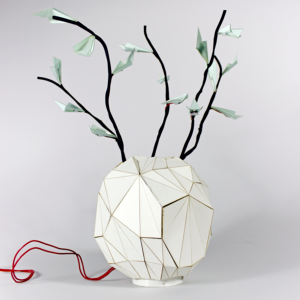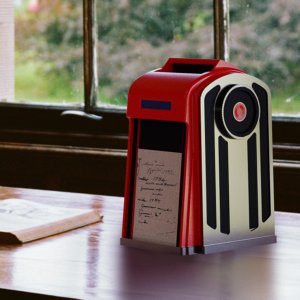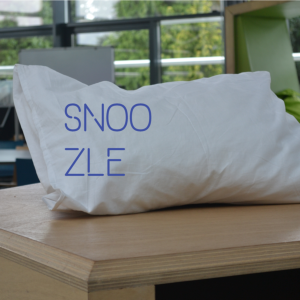Special UT projects at the Dutch Design Week in Eindhoven
UT students and researchers from different academical backgrounds take part in the Dutch Design Week (21-29 October) in Eindhoven. As part of 2500 designers, they present their work to more than 295,000 visitors in the biggest design event in Nothern Europe. At the 3TU exhibition “Mind the Step” they show their projects on the interface of technology, research, and design. An overview:
Smart Savoring
Designers: Geke Ludden, Edo de Wolf, Annemiek Klamer, Frederick Ho, Marina Orvananos, Szandra Somogyi, Samra Sabljic, Hannah Pelikan, Leonie Starmann, Saskia Hidding, Yanxin Wang, Andrea Garcia Negrete and Biying Zhang.
Conscious enjoyment of wonderful moments – Everyone responds differently to positive experiences/emotions and the good things in life. Where one person shares an experience or constructs active memories, another is aware of what they feel. Smart Savouring lets people consciously enjoy wonderful moments through Bloom-e, Felicia and Cloud-Out through three different interactions.
Bloom-e: Do the things that make you happy! The Bloom-e is a very special vase of flowers. The flowers become more beautiful and start to blossom when you do things that make you happy. You set yourself targets to do nice things, such as reading a book or taking a walk. The associated app checks your diary and gives you a signal when you have time for these targets. When you achieve the targets, you record the details with your app. Back home, you use your mobile to pour virtual water into the Bloom-e. The more targets you achieve, the more beautiful the flowers become.
Felicia: An extraordinary piece of jewellery that you can use to record those special moments. It may be a beautiful flower or an unusual sound that you hear. The jewellery can take a photo or record the sound. Later, you can look back or listen to these special moments. You will get to see or hear one of your special experiences at random. Felicia regularly heats up to remind you to record things. This is the trigger you need to focus on these special moments by recording them.
Cloud-out: The cloud-out is the design of an inviting chair that attracts your attention to sit down and relax. The chair appeals to various senses and gives you a special experience that encourages people to savour the moment. What makes the cloud-out so special is the silicon material that changes the texture. The exhibition features four samples in the form of cushions that demonstrate the changing texture.

OffLight
Designers: Merlijn Smits, Mark Beltman and Geke Ludden
The lamp that reconnects people - Real contact between people and old-fashioned quality time appears to be disappearing slowly. Smartphones have a lot to do with this. The OffLight reunites family and friends. The lamp lights up as soon as people place their smartphone in the corresponding station. The more telephones that are collected, the more atmospheric the light, the more mutual communication and, consequently, the friendlier the atmosphere.
App a Granny
Designers: Wessel Fletterman, Folkert Prins, Joran van der Sluis and Mark Zwart
Linking instant messaging with handwritten letter contact. App a Granny bridges the gap between traditional, ‘analogue’ seniors and modern, digital society through linking instant messaging with handwritten letter contact. Through a device that receives letters and digitizes them in Telegram. This existing medium feels just as familiar for seniors as the letterbox on the corner.

Aryzon
Designers: Niels Ruiter, Alex Ceha, Leon Schipper, Kay Hoogsteder and Maarten Slaa
An improved view of the real world with light-weight spectacles - Using the affordable AR visor ‘Aryzon’, 2.32 billion smartphone users can experience the magical world of Augmented Reality (AR). Different from Virtual Reality (VR), AR does not remove you from reality. It enriches a real environment through the addition of digital 3D information. Aryzon provides three-dimensional experiences. Through this, interactive 3D holograms appear, literally standing next to you.
Snoozle
Designers: Daniel Davison, Cristina Zaga, Jered Vroon, Jeroen Linssen, Jan Kolkmeier, Gijs Huisman, Merel Jung and Birna van Riemsdijk
Falling asleep peacefully on your robot pillow - Too little sleep is not good for our health. Even so, getting to bed on time can be difficult. Solutions often focus on sleep patterns. Not so with Snoozle. The robot pillow invites users to seek out their bed in time. Snoozle also improves the sleeping experience through enhancing a feeling of co-presence.
PLAYGORA: Designing for Real
Designers: Robert Wendrich, Olaf Grevenstuk, Arno van Dijk, Simone Hesseling, Sander Hetebrij and Werner Helmich
Individualized design combined with hybrid design tools have the capacity to act as the missing link between humans, society, and technology. The PLAYGORA design environment entails innovative interactive software solutions and design tools to create meaningful communication, experiences, personal involvement and social inclusion within various contexts and/or domains.

Biomimimetic Lifting Aid
Designers: Tjitte de Wolff and Emile van der Heide
A lifting aid with the strength of an octopus - The natural world is home to an inexhaustible source of knowledge for ground-breaking products. In this project knowledge of octopus suckers was transformed into a biomimetic lifting aid. This helps to move cumbersome objects through creating stable gripping points. The lifting aid anchors itself on rough surfaces and can resist great transverse forces. Just like an octopus.
Dynamic Balance
Designers: Jelle van Dijk and Valerie Mencke
Digital support when things get on top of you - Dynamic Balance gives people with autism more grip on their emotional lives. The product comprises an interactive watch and a smartphone app and offers support in a person’s emotion regulation process. Dynamic Balance subtly visualizes the arousal level and helps the user to reduce stress and calm down independently through self-recorded messages.
MIND
In addition to the Mind The Step exhibition, Dutch Design Week also features other Twente projects, including MIND: designing for dementia. Associate professor Geke Ludden will be joining Ingeborg Griffioen, director of the Panton design agency, to give a presentation about this unusual project at the Design Research & Innovation Festival DRIVE. Having reached halfway through the project, they will be presenting ideas for potential solutions. The project focuses on social relationships in the early stages of dementia. How can you support social relationships and how do you keep people engaged? Geke Ludden: “For people with dementia, receiving the diagnosis is a momentous occasion. It can often leave them feeling confused and even depressed. We are designing solutions to enable them to spend that time with those around them thinking about what the diagnosis means for them. And what the diagnosis will change for them in the future.”
It is still possible to register for the Design Research & Innovation Festival: https://www.aanmelder.nl/drive2017#.WeCaFFKB3-Y
Nature inspired design
The Nature Inspired Design project will also feature at DRIVE. UT scientists Thomas van Rompay and Geke Ludden are working on this project together with other scientists, including Karin Tanja-Dijkstra (UvA). Nature Inspired Design is exploring how and why nature has an effect on people’s well-being. What is it in nature that does this? How can we integrate nature into environments where it is difficult for people to have contact with nature, such as intensive care? At Philips Medical Lighting, a Master’s student of Industrial Design Engineering designed images of nature for an intensive care light that will be presented at DRIVE.
‘Textile reflexes’
At the ‘Do (not) feed the makers’ exhibition, on display in the building Sectie-C, the Textile Reflexes project will be presented. The project is a collaboration between the UT DesignLab (Geke Ludden and Angelika Mader) and Enschede-based textile and fashion designer Helen van Rees. It is receiving funding from Wear Sustain, a major consortium that is researching the future of wearable technology. How can developments in this field be made sustainable and remain so in the future? ‘Do not feed the makers’ will also feature a prototype of Robotic Textiles. This special jacket gives people feedback to help them adopt a good posture. If you slouch, it literally gives you a nudge in the back.
For further information please contact Hanna Dinkelbach (053 489 7704).





